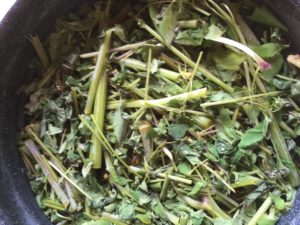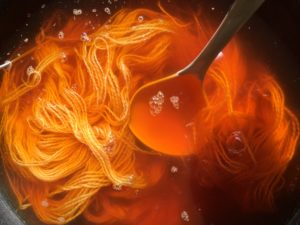
Jewelweed is a native North American plant that grows in many climates, usually near wet areas and along river banks. In the video, I share a method for creating beautiful natural tangerine dye using this abundant natural dye source.
I first learned about jewelweed as a dye source from a friend and fellow fiber farmer, Kristen Judkins of Gilead Fiber Farm. Here’s the method I’ve used.
Step 1: Prepare the yarn.
Mordant the wool with alum. I use a 10% by weight-of-goods proportion of alum to wool. Botanical Colors has a great tutorial on mordanting with alum.

Step 2: Prepare the jewelweed.
Here in Vermont, jewelweed matures and blooms in August. I use big pruning shears and lop off the whole plant a few inches above the soil. Gather a large bouquet which will dye approximately six 100-gram skeins of yarn (or equivalent amount of roving).
Roughly cut or chop the entire jewelweed plant and place pieces into a large dye kettle, filling the pot 2/3 or 3/4 full.
Step 3: Extract the dye and wet the yarn.
Place the pot on your heat source and top up with warm water, then add heat and bring to a gentle simmer (180 – 190 F). Stir occasionally and cook for about an hour.
While the color is extracting, wet your yarn out in hot water in a covered container (like a bucket or extra pot with a lid) to retain the heat.
When the color of the dye is looking saturated, strain off the liquid into another pot or bucket. I use a mesh paint strainer for this purpose to catch all the fine plant material.
Step 4: Dye the fiber.
Pour the dye liquid into your dye kettle and place back on the heat source.
Gently lift your yarn or fiber out of the soaking container and place into the dye kettle. Give it a gentle stir and poke to submerge.
Simmer the yarn in the dye bath for at least an hour, giving it a gentle swish every once in a while (too much agitation can felt the yarn so stirring should be infrequent).
After an hour, turn off the heat and cover the pot. I like to leave my dye kettles overnight to cool slowly.
Step 5: Rinse and dry.
Gently lift the fiber out of the dye kettle and allow the excess dye liquor to drain back into the pot. Then transfer to a bucket of clean water and let soak for a couple of minutes. If necessary, lift the fiber out of the rinse bucket and place into a third bucket or pot of clean water, to rinse a second time. I’ve found jewelweed doesn’t bleed much and doesn’t need much rinsing.
In a shady spot, hang the wet yarn up to dry or drape over the back of a lawn chair and allow to dry. You might want to bring the yarn inside after it stops dripping, as humidity in the air can keep it from drying completely outside.
Have you tried dying with jewelweed? We’d love to know. Leave a comment here or on the accompanying video and let us know how it turned out.


